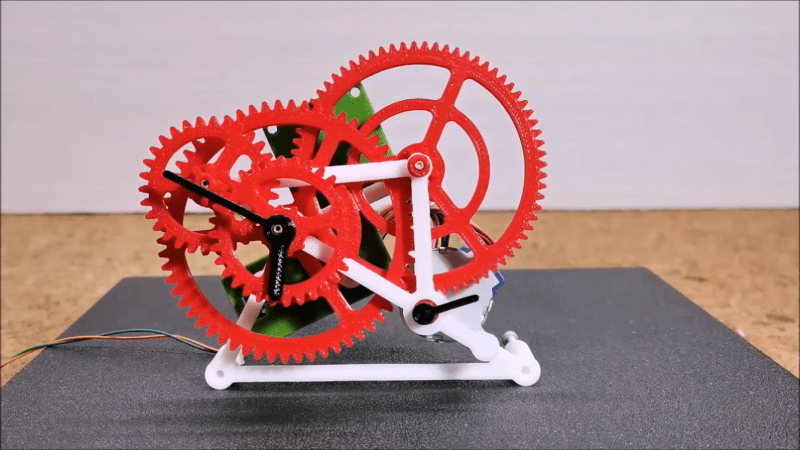Analog clocks are beautiful things inside, using ornate gear trains to keep track of time in a dance of mechanical beauty. However, all too often, the complexity is hidden inside. This gear clock design from [Tada3], however, proudly shows off its workings.
A small stepper motor is used to run the clock’s movement, a small part of the 28BYJ-48 variety. The motor is driven once per second, making the gear train tick along in a rather compelling way that is somehow more visually interesting. Of course, with some modification to the design, continuous motion could easily be done as well.
The stepper motor is driven by an Arduino Nano, which also handles the timekeeping. One thing that’s missing is a real-time clock, something that should be added to the design if you wish it to keep accurate time. As it is, the included Arduino sketch simply uses the delay() function to time the stepping of the motor. It makes the clock tick along, but will quickly drift out of sync.
The design was also recreated in a YouTube video by [Mirko Pavleski], showing that the files are of suitable quality for building your own at home. We’ve seen some gear clock designs before, too, from the laser-cut to the neatly-nested. Video after the break.















> a compelling way … that is more interesting
LOL
Meh… like a bicycle driven by a diesel engine.
I’d like to have a 3D printed antikythera mechanism.
This!
Not to nit-pick, but isn’t a clock that ticks every one second and has gears and the time can be precisely read numerically to one-second precision actually a “digital” clock, not “analog”? I think this is actually a “mechanical” and “digitial” clock, even though there are no numbers. If the motor ran continuously, not in steps, then it would be analog. Regardless, it’s a beautiful design!
Nearly all purely mechanical analog clocks tick along in discrete steps. This is by virtue of the escapement mechanism, and an important part of speed regulation. Does this make them no longer analog? What about clocks which tick at non-second intervals? Most fall into that category.
I think you might be among a very small pedantic minority in that assessment, so keep nit-picking, but be aware that effectively no one cares.
It would be hard to address all wrong statements in your response but I’d like to correct one:
“effectively no one cares”
For starters, he cares. That negates the claim that no one does
Anyone interested in _really_ understanding the concepts of analog and digital and how they apply to real world also does care, which makes two of us but probably many more
Analog refers to the hands, not the mechanism.
It’s a quantized analog system. It’s certainly not 1s and 0s.
I have to differ with the comment that a real time clock chip would make this more accurate. Such chips are typically driven by a cheap uncalibrated crystal and are no better and maybe worse than whatever crystal might be running your arduino.
If you want accuracy, the path is an NTP disciplined clock, so ditch the arduino and get an ESP of some kind.
The main virtue I see in RT clock chips is the ability to run in very low power modes from a coin battery when other power sources are not available.
@Severe Tire Damage said: “If you want accuracy, the path is an NTP disciplined clock, so ditch the arduino and get an ESP of some kind.”
Or you can use the PPS & NMEA-0183 output from a GPS/GNSS receiver. Just remember, as-is without software compensation (not trivial) the PPS time-valid edge is always one second late.
The gear ratio of those stepper motors is rather inconvenient – 63.68395:1 as stated here;
http://42bots.com/tutorials/28byj-48-stepper-motor-with-uln2003-driver-and-arduino-uno/
To covert one step per second from a real time clock to 60 steps per revolution for the second hand would be complicated.
At german Trainstations the (relatively famous) clock stops for “roughly” 2 seconds at 0 seconds which gives the opportunity to synchronize all the clocks basically once a minute across the station afaik.
Probably complicates more than it solves but it’s an option towards a rounder number to sync the two
It looks great of course, but this is just the gear-train, just the ‘display’ of the clock. The real magic in a mechanical clock is the escapement, and showing how that works is much more enlightening.
sorry. i stopped at the baked in add.